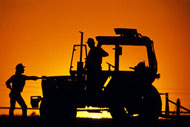AGRICULTURAL SAFETY

National Agricultural Workers Survey (NAWS)
Frequently Asked Questions
About NAWS
NAWS is an acronym for the National Agricultural Workers Survey. NAWS is an on-going survey conducted by the US Department of Labor, Employment and Training Administration (USDOL/ETA). NIOSH provided funding to USDOL/ETA to add an injury module to the general NAWS during 1999, 2002-2004, 2008-2010 and 2014-2015. The USDOL/ETA retains all rights to ownership of NAWS data.
NAWS is an employment-based probability sample of hired crop workers in the US that collects demographic, employment, and health data in face-to-face interviews. For more information about NAWS, go to USDOL/ETA- NAWS Questionnaire development and domains, and the current questionnaire.
An injury at work is one that resulted in a hired crop worker meeting at least one of the following criteria: (1) Unable to work for at least 4 hours; or (2) Unable to work as hard as normal for at least 4 hours or being assigned a different job task that was easier because of the injury; or (3) Received any type of first aid or medical treatment at a clinic or from a nurse or doctor; or (4) Used strong medicine (excluding aspirin, Tylenol, or ibuprofen) in order to keep working.
NAWS is an on-going survey conducted by the US Department of Labor, Employment and Training Administration (USDOL/ETA). Through an interagency agreement between the National Institute for Occupational Safety and Health (NIOSH) and the USDOL/ETA, NIOSH provided funding for USDOL/ETA to collect NAWS data on hired crop worker injuries occurring on US crop operations. Hired crop worker injury data were collected through face-to-face interviews for the years 1999, 2002-2004, 2008-2010 and 2014-2015. For more information about the general NAWS data system, go to USDOL/ETA- NAWS.
NAWS is an employer based, multi-stage probability sample survey that takes into account the seasonal and regional fluctuations in the level of farm employment. Seasonal fluctuations are accounted for by three interviewing cycles to incorporate nearly year around interviewing. All states are included except Alaska and Hawaii. The NAWS sample is stratified by 12 regions (see NAWS Regions). Within each region, farm labor areas consisting of counties (or several smaller counties aggregated) are selected from which a simple random sample of agricultural employers (growers) is selected. The end stage of the sampling process is a random sample of hired crop workers at each farm based on established protocol. Interviews are conducted in a location of the crop worker’s choice. The use of an employer-based sample (rather than a household-based sample) increases the likelihood that migrant and seasonal workers will be interviewed. For a detailed description of the sampling methodology, go to USDOL/ETA- NAWS Methods.
NAWS is designed to produce national percentage distributions for hired crop workers in the US for workers 14 years of age and older by various demographic and injury characteristics. Injury rates were calculated using NAWS employment estimates adjusted for weeks of farm work during the previous 12 months (see methods for rate calculations). Sampling weights are used in the NAWS so that population distributions may be obtained from the sample. For a detailed description of the sampling methodology, go to USDOL/ETA- NAWS Methods.
There are several limitations to the results from NAWS including eligibility criteria for workers being selected for an interview, a 12-month recall period for injury, and non-response bias. Also, it was not possible to verify the accuracy or completeness of the self-reported survey responses. Additional details of NAWS limitations are available in Steege et al. (2009), Wang et al. (2011), Tonozzi and Layne (2016) and USDOL/ETA- NAWS Data limitations.
Yes, the NAWS data are made publically available by USDOL/ETA. To access the data, go to USDOL/ETA- NAWS Public data content and file format. USDOL/ETA retains all rights to ownership of NAWS data.
Caution should be used in comparing the results from NAWS to those reported from other public health data sets. A careful review of the definitions, methods, and limitations of these data should be made before making comparisons to other published reports or studies of hired crop workers.
Yes. NAWS data can be used for aggregate statistical reporting and analysis only. The data available through NAWS are for public use and do not include information that would allow for the identification of an individual or a farm. NAWS users should:
- Use the NAWS data for aggregate or summary statistical reporting and analysis only.
- Not link NAWS results with individually identifiable data from other NIOSH or non-NIOSH data files.
- Make no use of the identity of any farm operation or individual discovered inadvertently and advise the Director, NIOSH, of any such discovery (800-35-NIOSH).
By using these data, you signify your agreement to comply with the above-stated statutorily based requirements.
When citing data obtained from NAWS, each citation should include the data source, the web address, and the date of access. The suggested citation is:
National Institute for Occupational Safety and Health (NIOSH). National Agricultural Workers Survey (NAWS) public-use data, 1999, 2002-2004, 2008-2010 and 2014-2015. June 2017. Accessed at https://www.cdc.gov/niosh/topics/aginjury/NAWS/ on [date of access].
